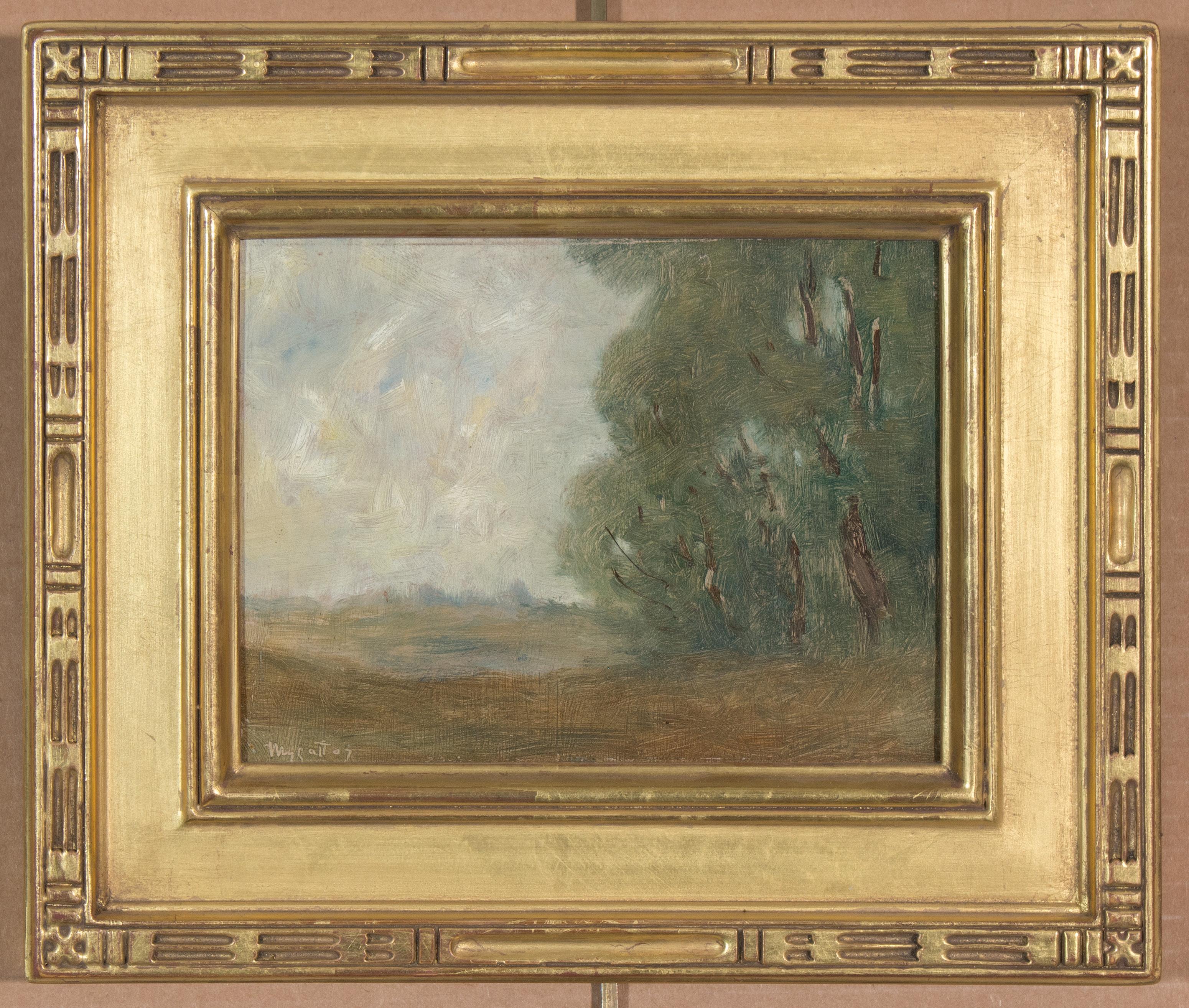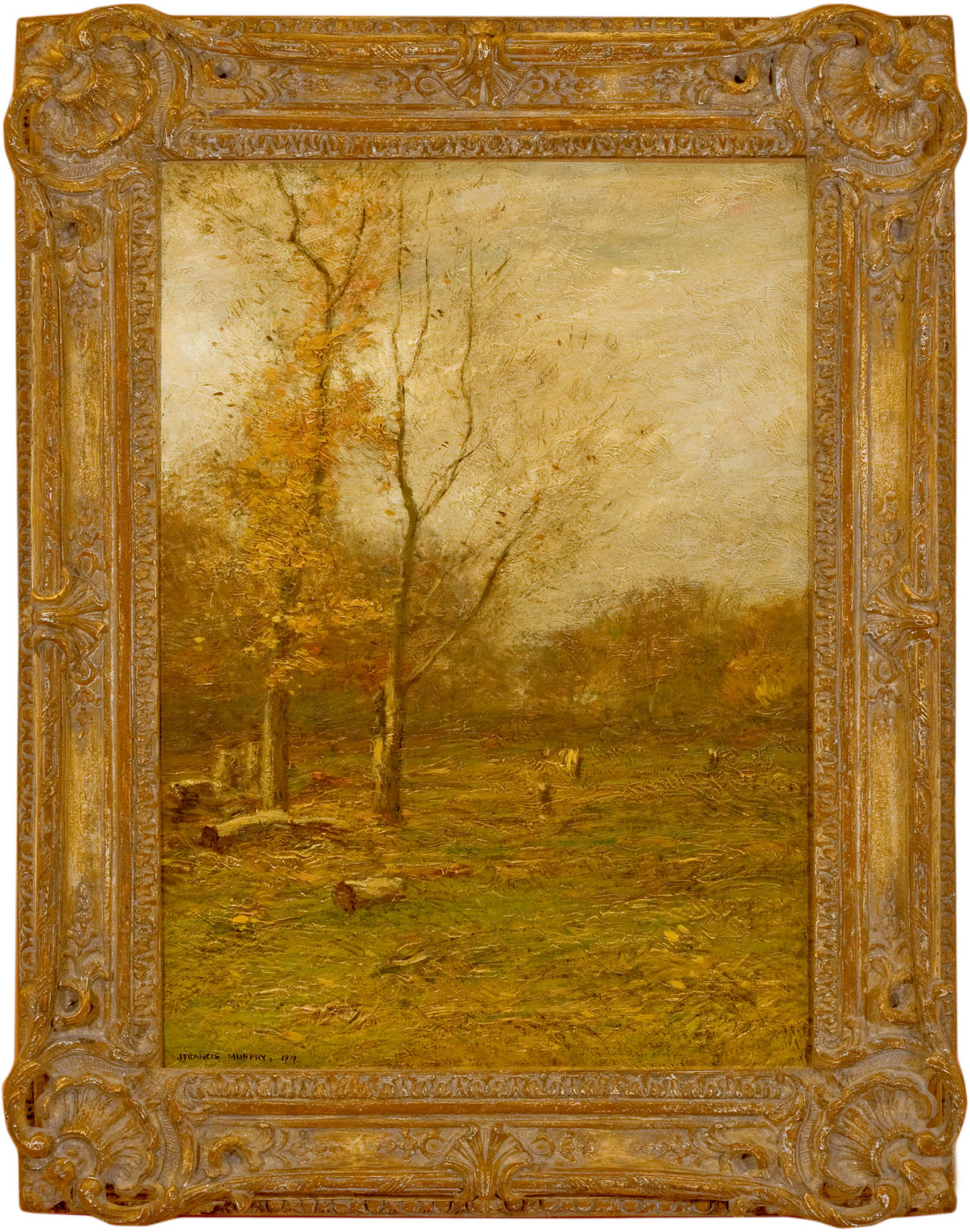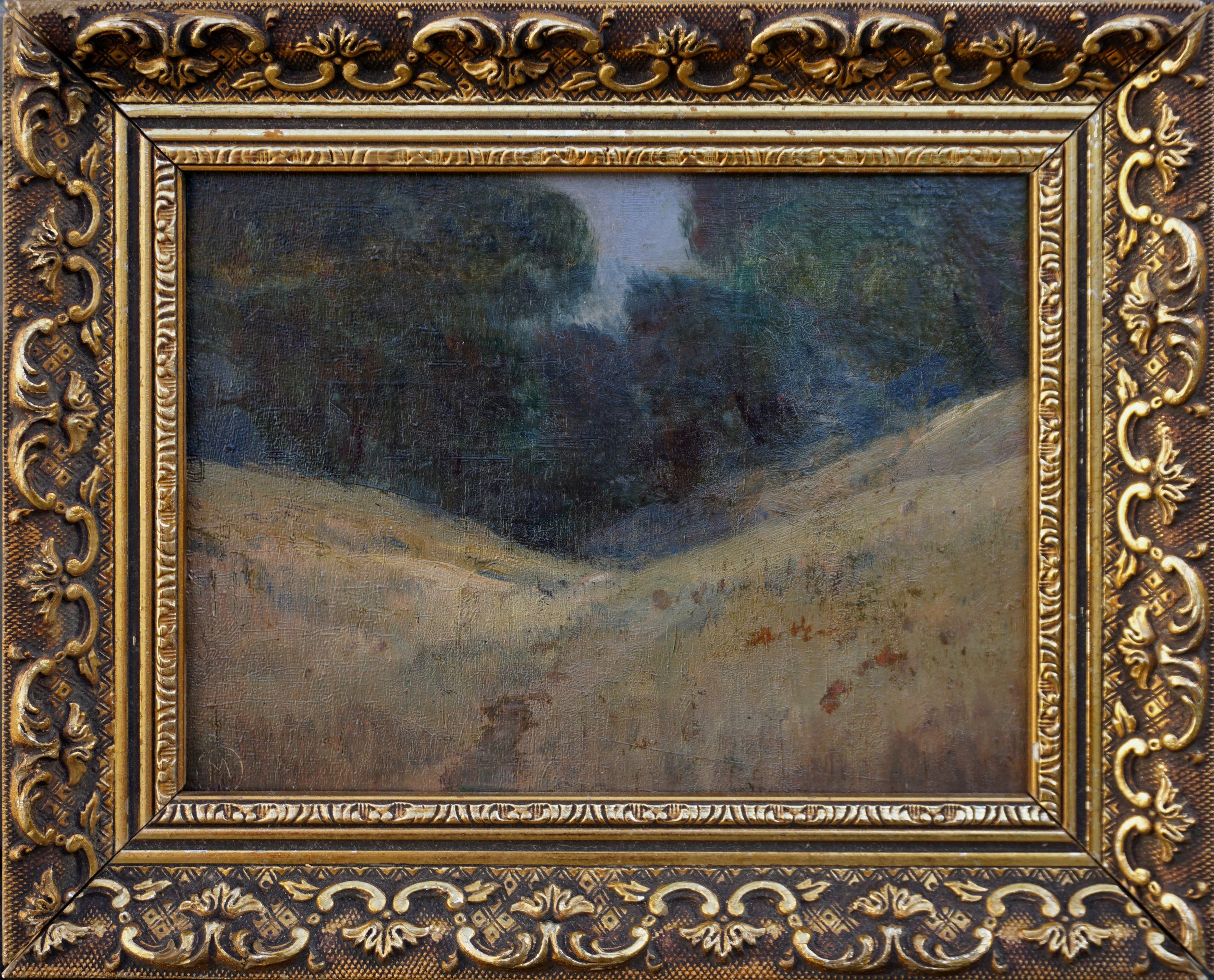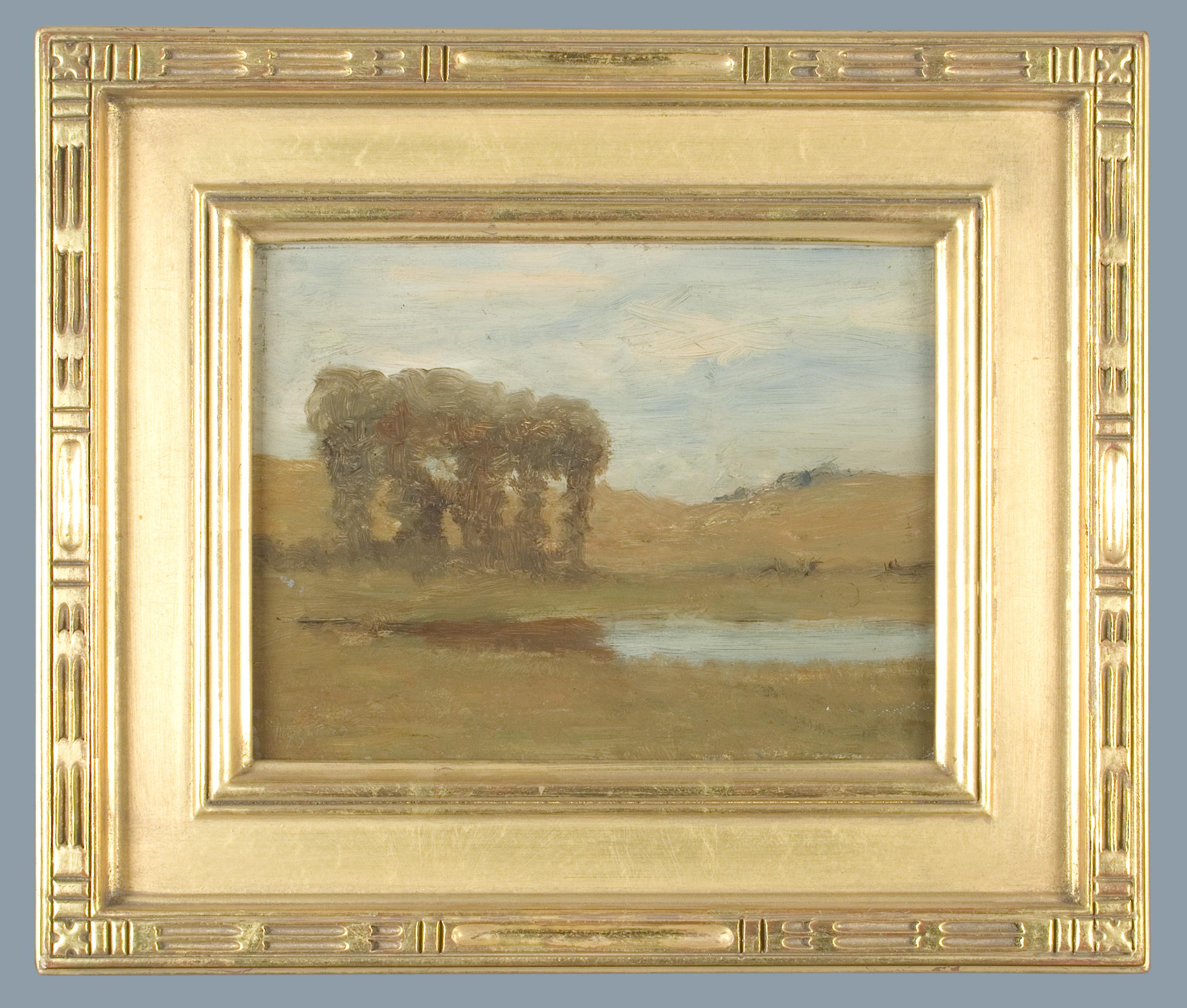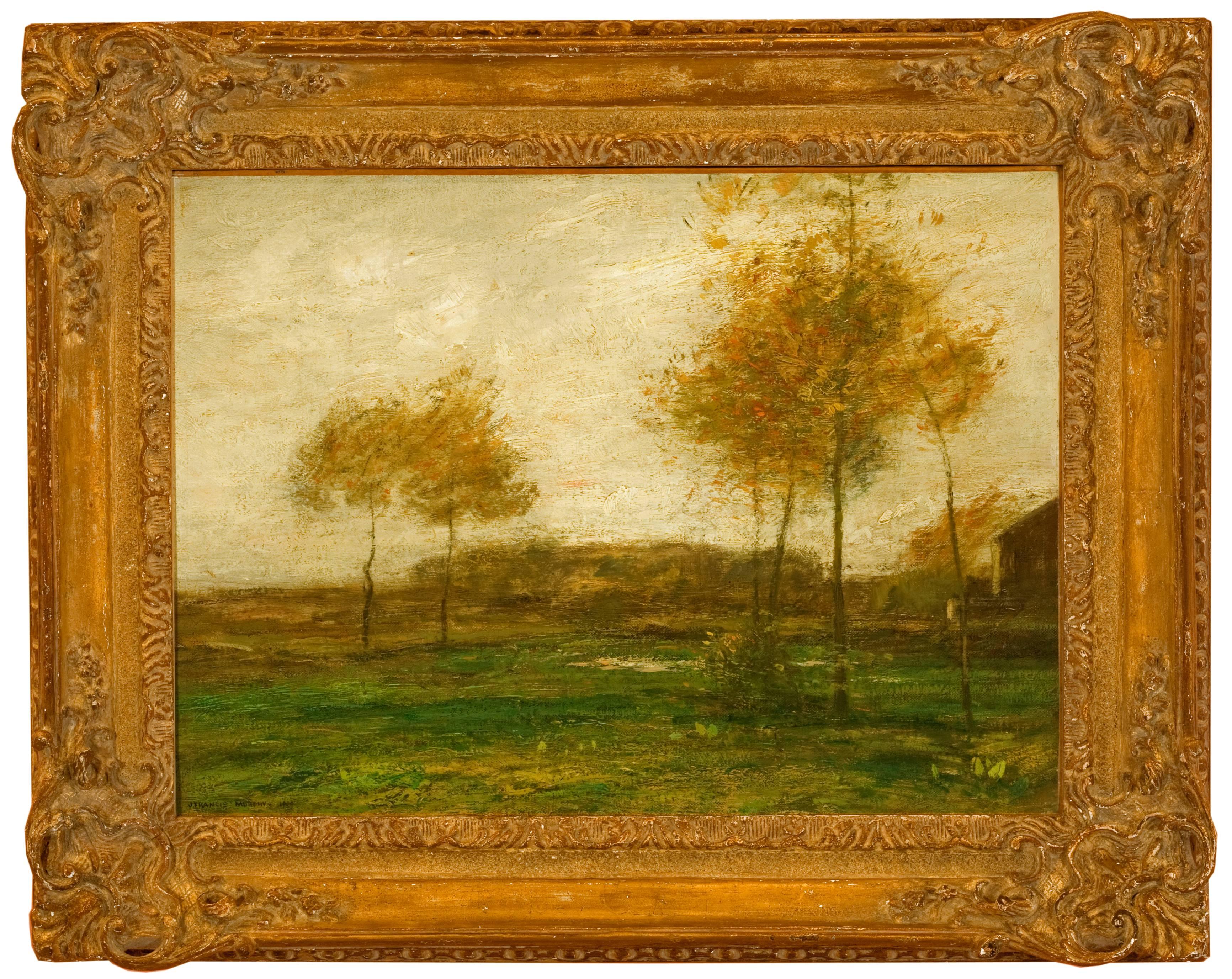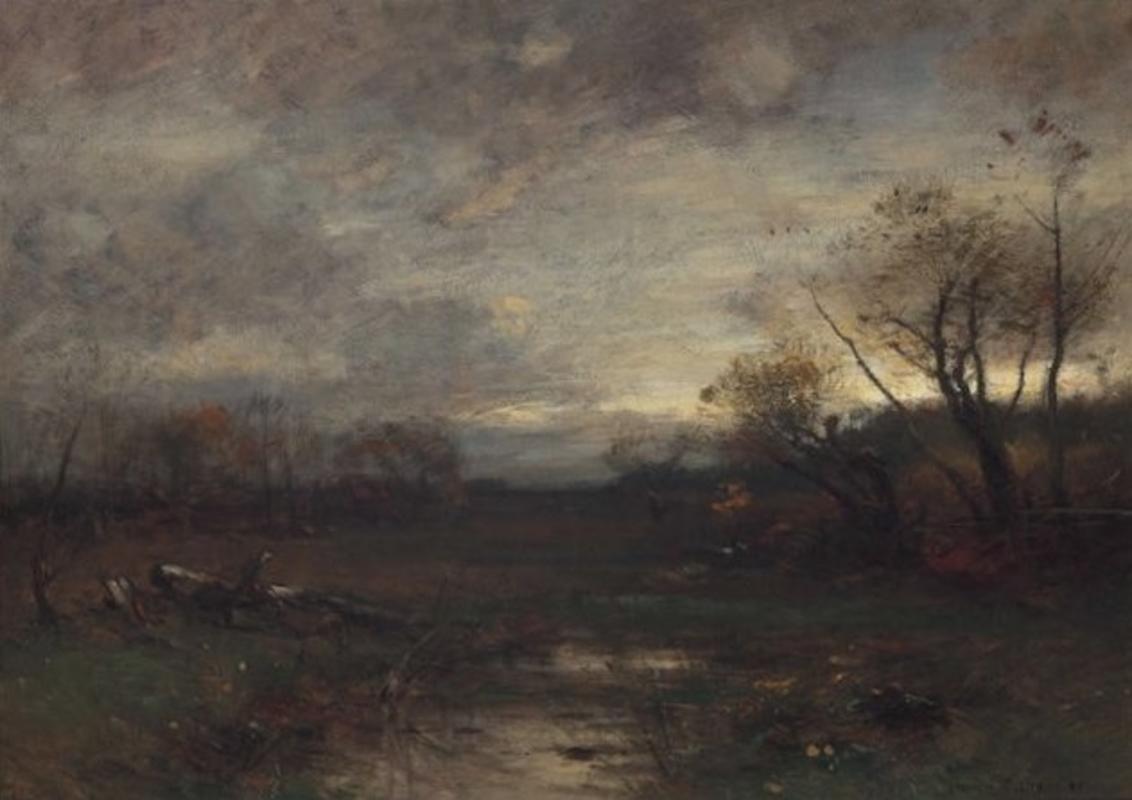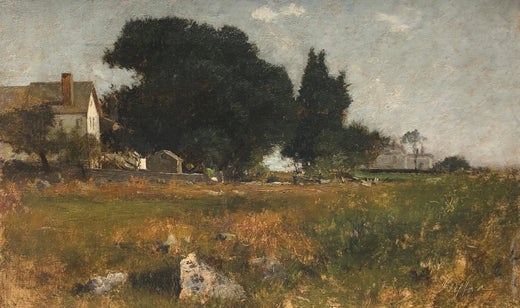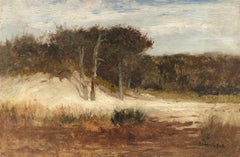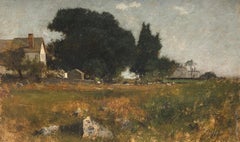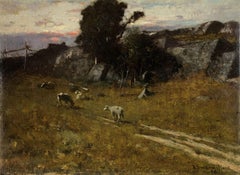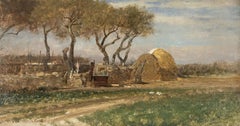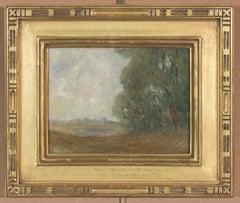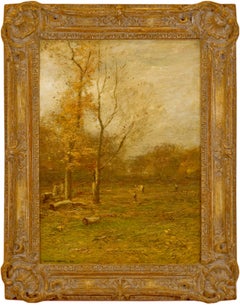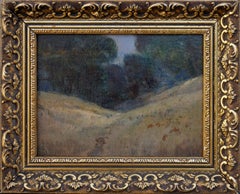Articles similaires à The Edge of the Forest
Vous voulez plus d'images ou de vidéos ?
Demander au vendeur plus d'images ou de vidéos
1 sur 5
Robert Swain GiffordThe Edge of the Forest
7 516,90 €
À propos de cet article
Robert Swain Gifford (1840–1905)
The Edge of the Forest
Oil on canvas, 15 x 23 1/4 inches (38.1 x 59.1 cm)
Estate stamp lower right: RSwain Gifford
Provenance
The artist;
By descent in the family to the artist's great-grandaughter, until 2023
Born on a small island near Martha's Vineyard, R. Swain Gifford and his family moved to the New Bedford, Massachusetts, area when he was two years old. The Dutch marine painter Albert Van Beest arrived in New Bedford in 1854, providing the teenage Gifford with the opportunity of study; he collaborated with Van Beest on a number of ship pictures and in 1857 accompanied the senior artist when he moved to New York. Nevertheless, Gifford's limited financial resources soon forced him to return to New Bedford. Seven years later he opened a studio in Boston, where he produced romantic marine paintings and views of storm-tossed ships derivative of Van Beest and another New Bedford influence, William Bradford.
By late 1865 Gifford had moved back to New York, and there he befriended the older painter Samuel Colman. They shared interests in watercolor painting and etching and together were instrumental in founding the American Society of Painters in Water Color in 1867 and the New York Etching Club in 1878.
The 1870s were filled with travel for Gifford. He went to the West Coast in 1869 to execute illustrations for the poet William Cullen Bryant's book Picturesque America, visited Europe and North Africa in 1870-71 with Louis Comfort Tiffany, and made a more extensive European and North African sojourn in 1873-75 with his new wife, the artist Frances ("Fanny") Eliot. Gifford's travels abroad had a formative impact: he was exposed to the Oriental subject matter that immediately became a specialty and introduced to the Barbizon landscape style that characterized his later views of the New England coast.
In 1877 Gifford began an affiliation with the Cooper Union schools that lasted until his death; he gradually rose from the position of painting instructor to become art director of all the Cooper Union schools.
In later years Gifford divided his time between New York and a summer home in Nonquitt, Massachusetts. He also traveled extensively, going to Florida, Canada, and Europe, and accompanying the railroad magnate E. H. Harriman on his scientific expedition to Alaska in 1899. Gifford's interest in the relationship of art and science is documented in the Academy's library register; between 1867 and 1895 he checked out books on Goethe's theory of colors, on the anatomy of expression, and on the writings of Leonardo da Vinci.
Although he was an important figure in the Society of American Artists, serving as its vice-president (1878-79) and on its advisory board (1900-1901), Gifford was also devoted to the National Academy. A regular participant in the annual exhibitions from 1863, he also served on the Council from 1886 to 1889 and from 1902 until the year of his death. A memorial exhibition of Gifford's work was organized at the Century Association, New York, in 1905.
- Créateur:Robert Swain Gifford (1840-1905, Américain)
- Dimensions:Hauteur : 38,1 cm (15 po)Largeur : 59,06 cm (23,25 po)
- Autres éditions et dimensions:nonePrix : 7 517 €
- Support:
- Mouvement et style:
- Période:
- État:All works offered by this seller are in very good to excellent condition. Please contact us for a detailed condition report.
- Adresse de la galerie:Bryn Mawr, PA
- Numéro de référence:1stDibs : LU2773215026972
Robert Swain Gifford
Robert Swain Gifford (1840-1905) Robert Swain Gifford était un peintre paysagiste américain surtout connu pour ses scènes côtières évocatrices et ses paysages atmosphériques. Il est né le 23 juillet 1840 sur l'île de Naushon, qui fait partie des îles Elizabeth dans le Massachusetts. Vie et formation Gifford déménage avec sa famille à New Bedford, dans le Massachusetts, où il s'intéresse très tôt à l'art. Il commence une formation formelle avec l'artiste néerlandais Albert van Beest, qui a une influence significative sur son style, en particulier pour les sujets marins. Voyages et influence Le développement artistique de Gifford a été profondément marqué par de nombreux voyages :
Dans les années 1860, il visite la Californie et peint ses côtes escarpées. Il a également voyagé en Europe, en Afrique du Nord et au Moyen-Orient, produisant des œuvres inspirées par des paysages exotiques et arides, qui le distinguent de nombre de ses contemporains. Style et héritage Le travail de Lumin mêle luminisme et tonalisme, se concentrant sur l'ambiance, la lumière et l'atmosphère plutôt que sur les détails complexes. Il a peint à la fois à l'huile et à l'aquarelle, capturant souvent des scènes tranquilles et méditatives de marais, de ports et de déserts. Son art reflète une fascination pour la lumière naturelle et les variations subtiles de tons, et il était particulièrement doué pour dépeindre des paysages marins brumeux et des vues côtières éloignées. Faits marquants de sa carrière Élu académicien à part entière à la National Academy of Design en 1867.
Exposé régulièrement dans des institutions majeures, dont le Boston Art Club, la Pennsylvania Academy of the Fine Arts et le Metropolitan Museum of Art.
A reçu une médaille à l'Exposition Universelle de Paris en 1889. Décès et reconnaissance Gifford est décédé en 1905 à New York. Aujourd'hui, ses œuvres sont conservées dans des collections prestigieuses, notamment : Le Metropolitan Museum of Art Le Smithsonian American Art Museum
Le musée des beaux-arts de Boston
À propos du vendeur
5,0
Vendeur reconnu
Ces vendeurs prestigieux sont des leaders du secteur. Ils représentent le summum en matière de qualité et de design.
Vendeur Platine
Vendeurs premium dont la note est supérieure à 4,7 et le délai de réponse de 24 heures maximum
Établi en 2001
Vendeur 1stDibs depuis 2024
6 ventes sur 1stDibs
- ExpéditionRecherche du devis...Expédition depuis : Bryn Mawr, PA
- Politique des retours
Certaines parties de cette page ont été traduites automatiquement. 1stDibs ne garantit pas l'exactitude des traductions. L'anglais est la langue par défaut de ce site web.
Garantie d'authenticité
Bien qu'il soit peu probable que la situation se présente, dans le cas où vous rencontreriez un problème d'authenticité d'un article, contactez-nous dans un délai d'un an pour obtenir un remboursement intégral. DétailsGarantie de remboursement
Si votre article n'est pas conforme à la description, est endommagé pendant le transport ou ne vous est pas livré, contactez-nous sous 7 jours pour obtenir un remboursement intégral. DétailsAnnulation sous 24 heures
Vous disposez d'un délai de 24 heures pour annuler votre achat sans motif.Des vendeurs professionnels agréés
Nos vendeurs de renommée mondiale doivent respecter des normes strictes en matière de service et de qualité, afin de préserver l'intégrité de nos fiches produit.Garantie d'alignement des prix
Si vous constatez qu'un autre vendeur a mis en vente le même article à un prix inférieur sur un autre site, nous nous alignerons sur ce prix.Livraison en toute confiance à l'international
Notre réseau de transporteurs de premier ordre propose des options d'expédition spécialisées dans le monde entier, y compris des livraisons personnalisées.Plus d'articles de ce vendeur
Tout afficherWood Wood Dune de sable
Par Robert Swain Gifford
Wood Wood Dune de sable
Huile sur panneau, 12 x 18 1/8 pouces
Dimensions encadrées : 17 1/2 x 23 1/2 pouces
Timbre de succession en bas à droite : RSwain Gifford
Provenance
L'artist...
Catégorie
Fin du XIXe siècle, École de Barbizon, Peintures - Paysage
Matériaux
Huile, Panneau en bois
Ferme de Nouvelle-Angleterre
Par Robert Swain Gifford
Provenance
L'artiste ;
Par descendance dans la famille jusqu'à l'arrière-petite-fille de l'artiste, jusqu'en 2023.
Né sur une petite île près de Martha's Vineyard, R. Swain Gifford ...
Catégorie
Fin du XIXe siècle, École de Barbizon, Peintures - Paysage
Matériaux
Toile, Huile
Paysage du soir
Par Robert Swain Gifford
Né sur une petite île près de Martha's Vineyard, R. Swain Gifford et sa famille ont déménagé dans la région de New Bedford, dans le Massachusetts, lorsqu'il avait deux ans. Le peintr...
Catégorie
années 1880, École de Barbizon, Peintures - Paysage
Matériaux
Toile, Huile
Landscape with Haystacks
Par Robert Swain Gifford
Robert Swain Gifford (1840–1905)
Landscape with Haystacks
Oil on canvas, 14 1/8 x 24 inches (35.9 x 61 cm)
Estate stamp lower left: RSwain Gifford
Provenance
The artist;
By descent...
Catégorie
XIXe siècle, Peintures - Paysage
Matériaux
Huile
Scène de forêt
Par William Bliss Baker
Scène de forêt, 1885
Huile sur toile, 38 x 50 pouces (96,5 x 127 cm)
Dimensions encadrées : 49 3/8 x 61 3/8 pouces
Signé et daté en bas à gauche : W Bliss Baker 1885
Provenance
Albe...
Catégorie
années 1880, Hudson River School, Peintures - Paysage
Matériaux
Huile, Toile
82 906 € Prix de vente
25 % de remise
Les lumières de l'après-midi
Par Walter Launt Palmer
Les lumières de l'après-midi
Huile sur toile, 16 1/4 x 12 1/4 pouces (41,3 x 31,1 cm)
Dimensions encadrées : 22 1/4 x 18 1/4 pouces
Signé en bas à droite : I.L.A. Palmer
Provenance
...
Catégorie
Début du XXe siècle, Impressionnisme américain, Peintures - Paysage
Matériaux
Toile, Huile
Suggestions
Landscape: the Uplands de l'artiste du Massachusetts Robertson Mygatt
Robertson K.K. Mygatt
(Américain, 1862-1919)
Hautes terres
Huile sur panneau, 5 1/4 x 6 5/8 pouces
ENCADRÉ : 9 x 10 1/2 pouces (approx.)
Étiquette d'exposition au verso : "Salamagund...
Catégorie
Début des années 1900, Tonalisme, Peintures - Paysage
Matériaux
Huile, Panneau
« Un ancien transparent »
Par John Francis Murphy
Jim's of Lambertville est fier d'offrir cette œuvre d'art.
Signé et daté en bas à gauche.
John Francis Murphy (1853 - 1921)
John Francis Murphy est de plus en plus reconnu aujour...
Catégorie
Années 1910, Tonalisme, Peintures - Paysage
Matériaux
Huile, Toile
Paysage tonaliste de la fin du 19e siècle avec Oak Trees
Par Willard LeRoy Metcalf
Magnifique peinture de paysage tonaliste de la fin du XIXe siècle représentant des contreforts et des chênes dans le style de Willard LeRoy Metcalf vers 1900. Inscrit "M" dans un monogramme circulaire dans le coin inférieur gauche et au verso du cadre. Présenté dans son cadre d'origine en bois doré rustique. Taille de l'image : 6 "H x 8 "W. Dimensions du cadre : 8,5 "H x 10,5 "W.
Les œuvres tonales sont généralement des œuvres intimes, peintes avec une palette limitée. Les peintures tonales sont doucement expressives, suggestives plutôt que détaillées, et représentent souvent le paysage au crépuscule ou le soir, lorsqu'il n'y a pas de contraste. Les peintures tonalistes pouvaient également être figuratives, mais dans celles-ci, la figure était généralement à l'extérieur ou dans un intérieur, dans un cadre discret avec peu de détails.
Le tonalisme trouve son origine dans les œuvres de l'école française de Barbizon et dans les œuvres des peintres américains influencés par cette école. Le tonalisme californien est né lorsque l'accent mis sur la peinture de paysage californienne est passé des paysages grandioses d'œuvres comme celles de Thomas Hill...
Catégorie
années 1890, Tonalisme, Peintures - Paysage
Matériaux
Huile, Carton
6 013 € Prix de vente
20 % de remise
Petit paysage tonaliste de Robertson Mygatt
Robertson K.K. Mygatt
(Américain, 1862-1919)
Arbres au bord d'un petit étang
Huile sur panneau, 5 1/8 x 6 3/4 pouces
Encadré : 9 1/2 x 11 1/2 pouces (approx.)
Le peintre paysagiste ...
Catégorie
Début des années 1900, Tonalisme, Peintures - Paysage
Matériaux
Huile, Panneau
« The Low Lands » (les terres basses)
Par John Francis Murphy
Jim's of Lambertville est fier d'offrir cette œuvre d'art.
Signé et daté en bas à gauche
John Francis Murphy (1853 - 1921)
John Francis Murphy est de plus en plus reconnu aujour...
Catégorie
Début des années 1900, Tonalisme, Peintures - Paysage
Matériaux
Toile, Huile
Paysage tonaliste d'été/automne « Late Afternoon » de J. Francis Murphy
Par John Francis Murphy
John Francis Murphy (Américain, 1853 - 1921)
Fin d'après-midi, 1895
Huile sur toile
14 x 19 pouces
Signé et daté en bas à droite
Il est logé dans un cadre cannelé de reproduction.
P...
Catégorie
années 1890, Tonalisme, Peintures - Paysage
Matériaux
Toile, Huile
